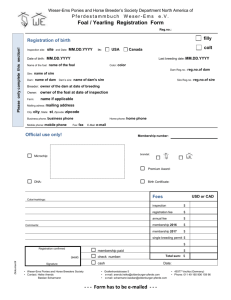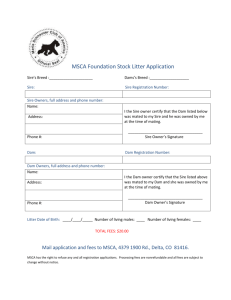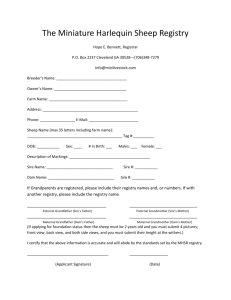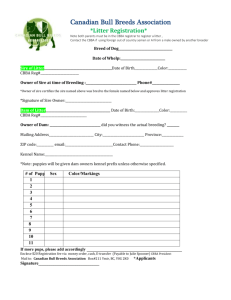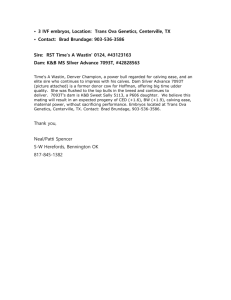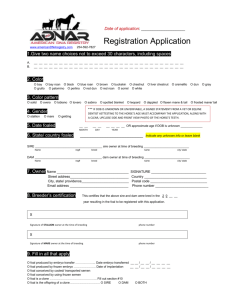ColorWheel - The Horse Gazette
advertisement
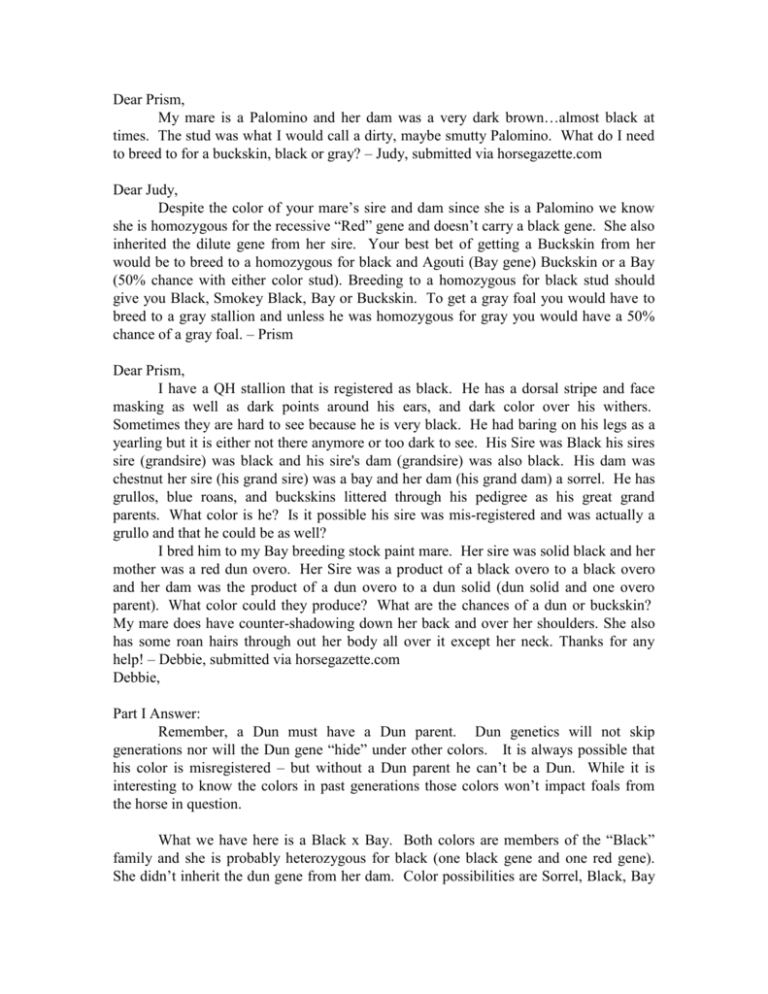
Dear Prism, My mare is a Palomino and her dam was a very dark brown…almost black at times. The stud was what I would call a dirty, maybe smutty Palomino. What do I need to breed to for a buckskin, black or gray? – Judy, submitted via horsegazette.com Dear Judy, Despite the color of your mare’s sire and dam since she is a Palomino we know she is homozygous for the recessive “Red” gene and doesn’t carry a black gene. She also inherited the dilute gene from her sire. Your best bet of getting a Buckskin from her would be to breed to a homozygous for black and Agouti (Bay gene) Buckskin or a Bay (50% chance with either color stud). Breeding to a homozygous for black stud should give you Black, Smokey Black, Bay or Buckskin. To get a gray foal you would have to breed to a gray stallion and unless he was homozygous for gray you would have a 50% chance of a gray foal. – Prism Dear Prism, I have a QH stallion that is registered as black. He has a dorsal stripe and face masking as well as dark points around his ears, and dark color over his withers. Sometimes they are hard to see because he is very black. He had baring on his legs as a yearling but it is either not there anymore or too dark to see. His Sire was Black his sires sire (grandsire) was black and his sire's dam (grandsire) was also black. His dam was chestnut her sire (his grand sire) was a bay and her dam (his grand dam) a sorrel. He has grullos, blue roans, and buckskins littered through his pedigree as his great grand parents. What color is he? Is it possible his sire was mis-registered and was actually a grullo and that he could be as well? I bred him to my Bay breeding stock paint mare. Her sire was solid black and her mother was a red dun overo. Her Sire was a product of a black overo to a black overo and her dam was the product of a dun overo to a dun solid (dun solid and one overo parent). What color could they produce? What are the chances of a dun or buckskin? My mare does have counter-shadowing down her back and over her shoulders. She also has some roan hairs through out her body all over it except her neck. Thanks for any help! – Debbie, submitted via horsegazette.com Debbie, Part I Answer: Remember, a Dun must have a Dun parent. Dun genetics will not skip generations nor will the Dun gene “hide” under other colors. It is always possible that his color is misregistered – but without a Dun parent he can’t be a Dun. While it is interesting to know the colors in past generations those colors won’t impact foals from the horse in question. What we have here is a Black x Bay. Both colors are members of the “Black” family and she is probably heterozygous for black (one black gene and one red gene). She didn’t inherit the dun gene from her dam. Color possibilities are Sorrel, Black, Bay or Brown. Without either parent being a Dun, you can’t get a Dun foal. Same with a Buckskin – one parent must carry the Dilution gene for the foal to inherit. Roan also follows the same rules as Dun; a Roan must have a Roan parent. What your mare is evidencing the “Rabicino” genetics. This is a random occurrence of white hairs throughout the body and can occur in offspring of non-roan parents. “Rabicino” marked horses may never produce a Rabicino foal. – Prism Dear Prism, My question is not about coat color, but eye color. Is there any information available about what causes blue eyes to occur in horses? She has a QH stallion that we have determined to carry the sabino gene. He does not have ANY abnormal markings, but many of his foals have high knee socks, wide blazes and chin spots. They are otherwise solid foals. Some of the foals are coming up with blue eyes. Their white blaze/star does not cover their eyes/go behind their eye. I have studied coat color a lot and understand most all of that. But I have yet to be able to locate anything about what actually makes the eyes blue. I know that blue eyes are not a real common sabino trait...moreso overo. But it is no doubt the sabino gene that is present. All the other marks/traits are classic for sabino. I'd greatly appreciate any insight you may be able to give me on this. Thanks – Chastity, submitted via horsegazette.com Dear Chastity, Many times a Sabino is so minimal that it would appear to be a non-paint in every way. These “slipped” patterns can still produce Paint color. Which will explain the high whites and face white on offspring. Sabino is also one of the three (3) Overo patterns, they are Frame, Sabino and Splash Overo and most non-Tobiano horses will carry more than one paint pattern. I know of a few classic Tobianos that also carry Overo genetics. It’s difficult to classify paint patterns since we don’t have genetic testing to identify them. As far as the blue eyes there really has been no research done on how the blue-eyed gene is transmitted or passed. Will be interesting when they identify and define the blue eye gene. – Prism Dear Prism, New question for ya! I am trying to register a 7-month-old 3/4 Arab filly. Her sire is a very pale Dun (close to buttermilk/dark eyes). He has taupe colored legs and dorsal stripe. His sire was a dark Buckskin and his dam was grey. The dam of this filly is chestnut, as well as her sire and dam. The filly is graying around her face, legs are blackish, her body color is bay/grey (roan?) with grey undertones and dark skin. I assumed she is a grey. Registry says NO...she has to have one grey parent to be a grey. She doesn't have a black head...rules out blue roan. She doesn't look to be grullo. Now I have to refile the registration and send pictures. What do you think? Please reply ASAP. Thanks! William Dear William, Basically, you have a gray filly regardless of what the registry says. Given the color description of her sire I'd say he was a Buckskin turning gray and was mis- registered as a Buckskin based on his foal/birth color. Is there anyway you can get current pictures and a signed statement from the stallion owners that he is now gray; possibly get his papers corrected? Or you could run a produce of sire record on him and see how many of those foals are grays when bred to non-gray mares. Otherwise, you just need to send in new pics of the filly showing the gray hairs and a color pedigree for the stud showing that his dam was gray and he is now gray and not buckskin. Unfortunately, there are many horses out there, which are mis-registered as to color - each owner/breeder needs to follow-up on these animals and correct the paperwork to reflect current color. Don't know of another way to get the point across to the registries than just keep after them and show them where the color anomaly occurred. - Prism
